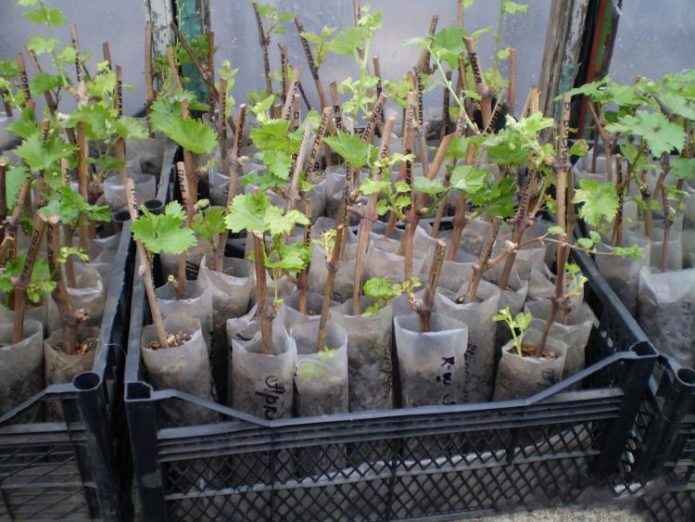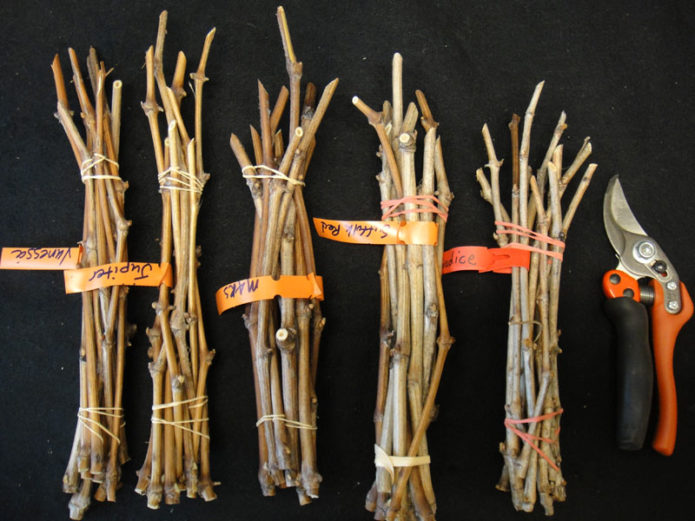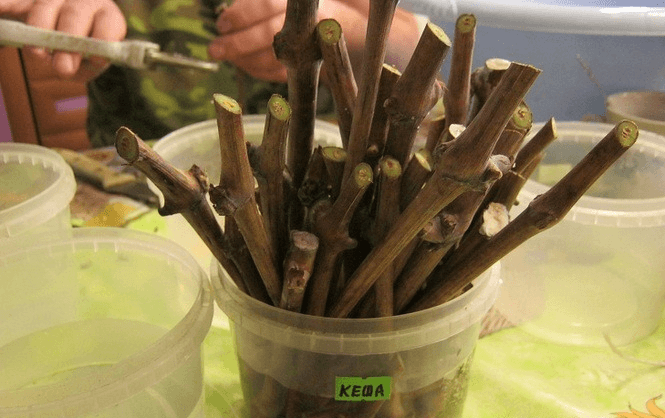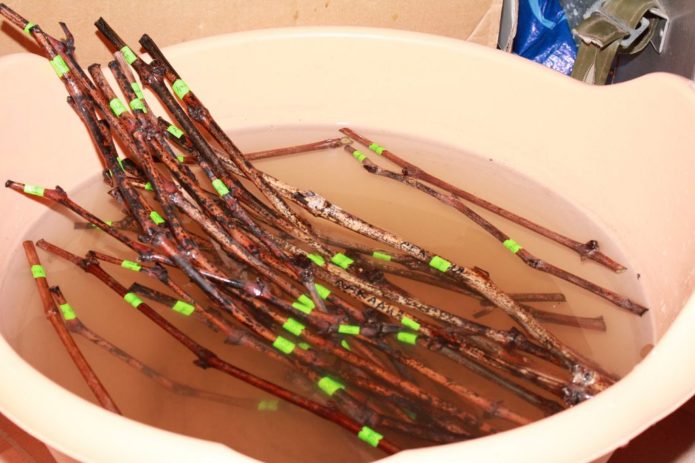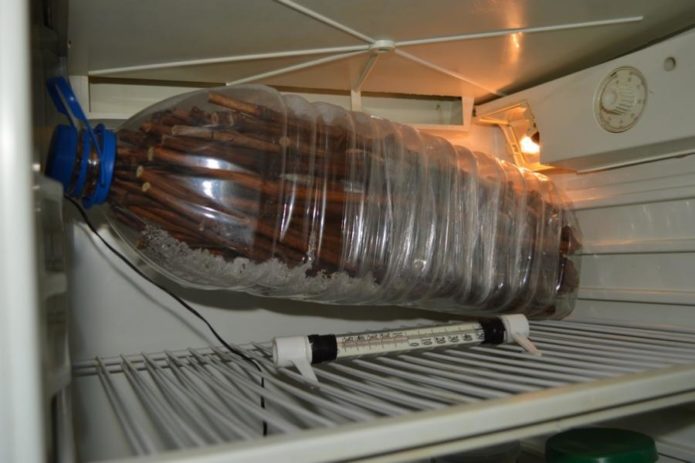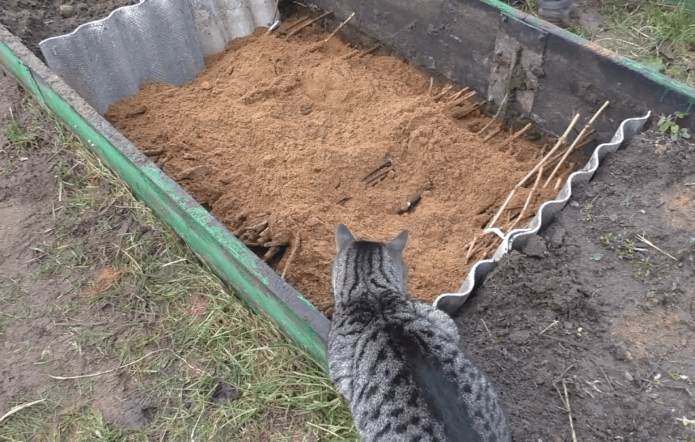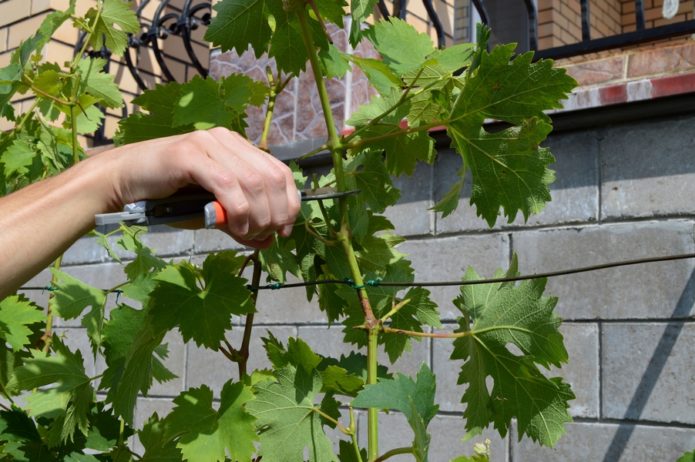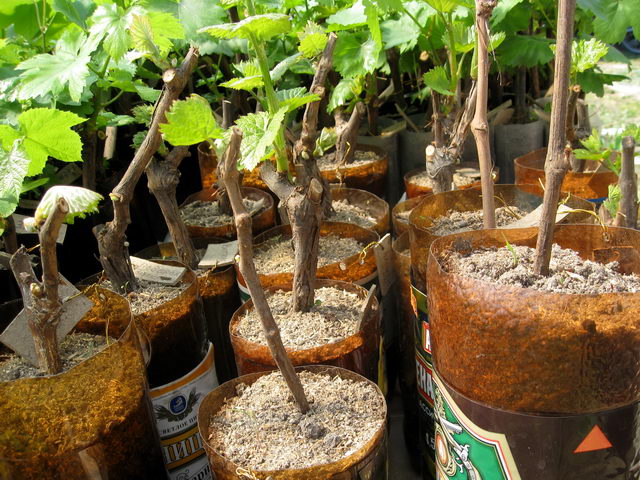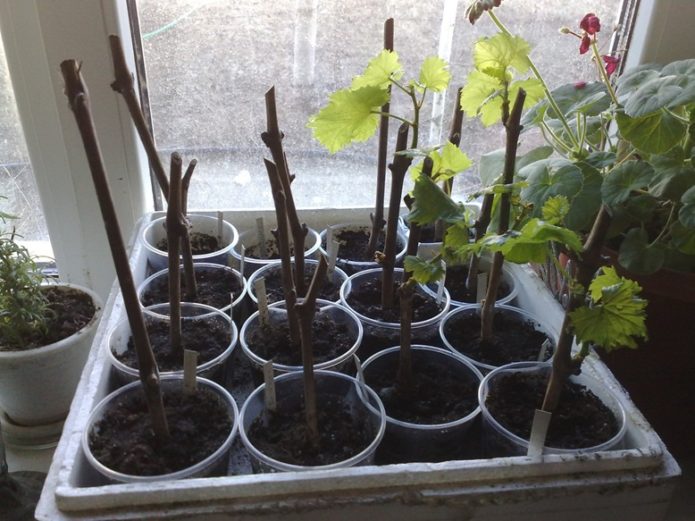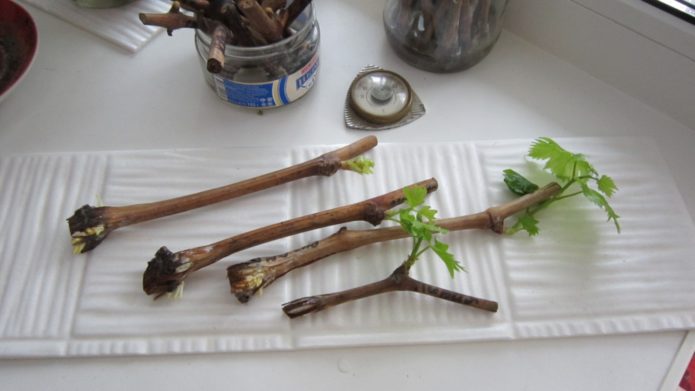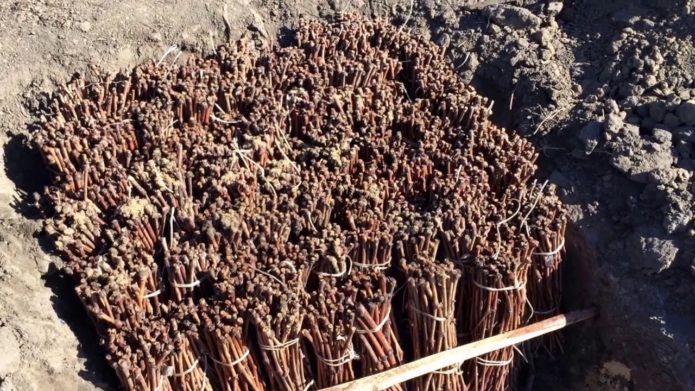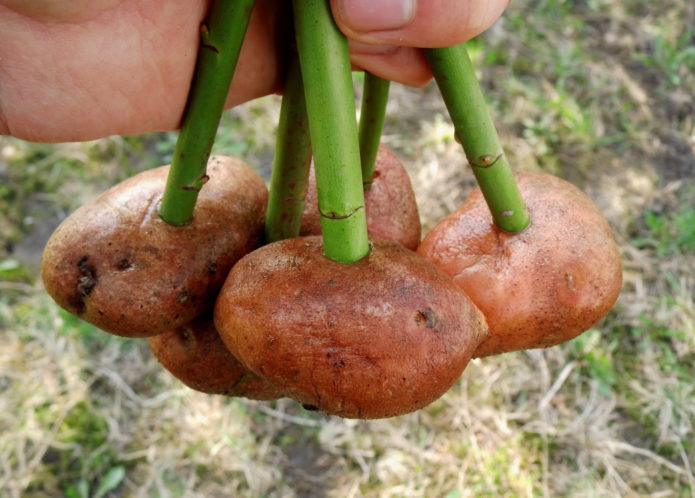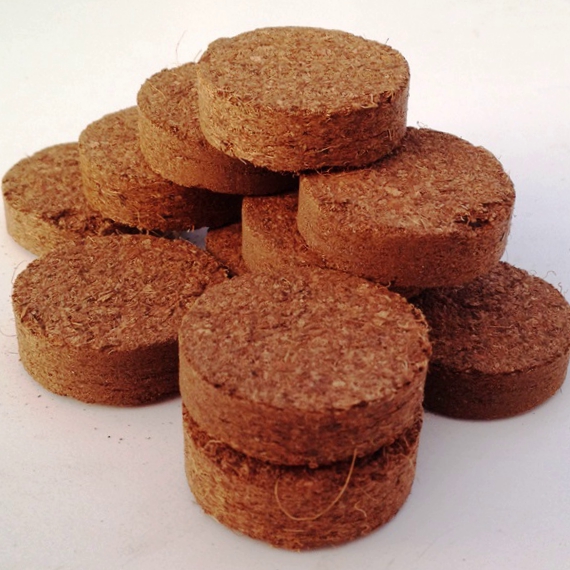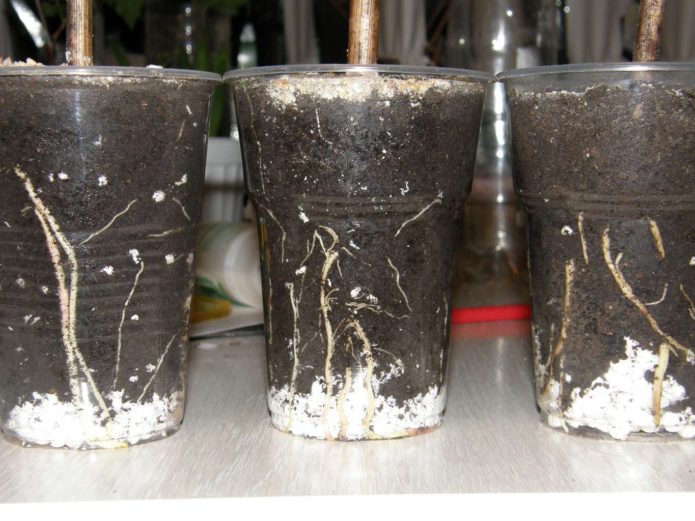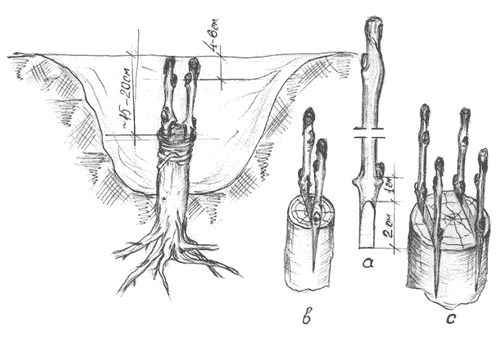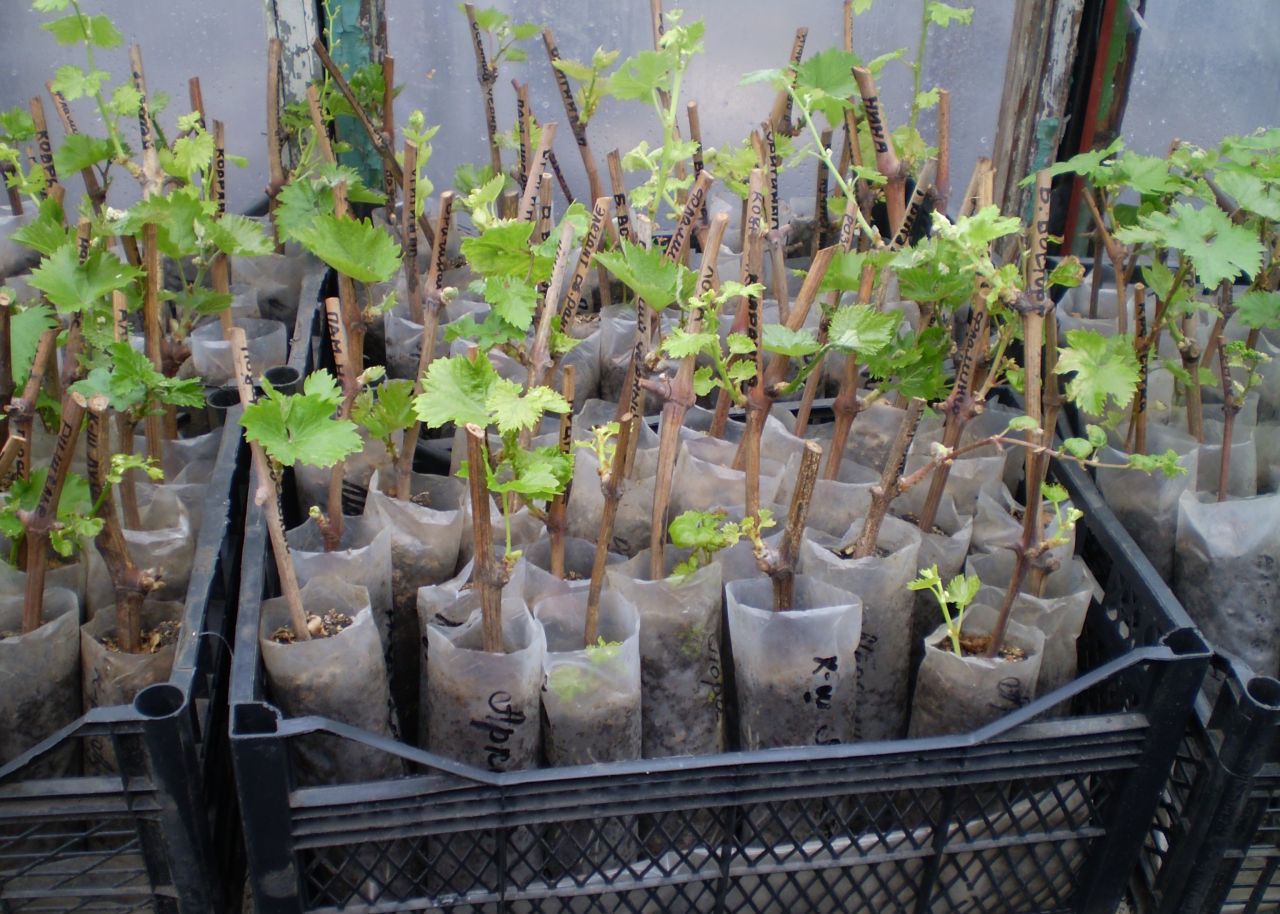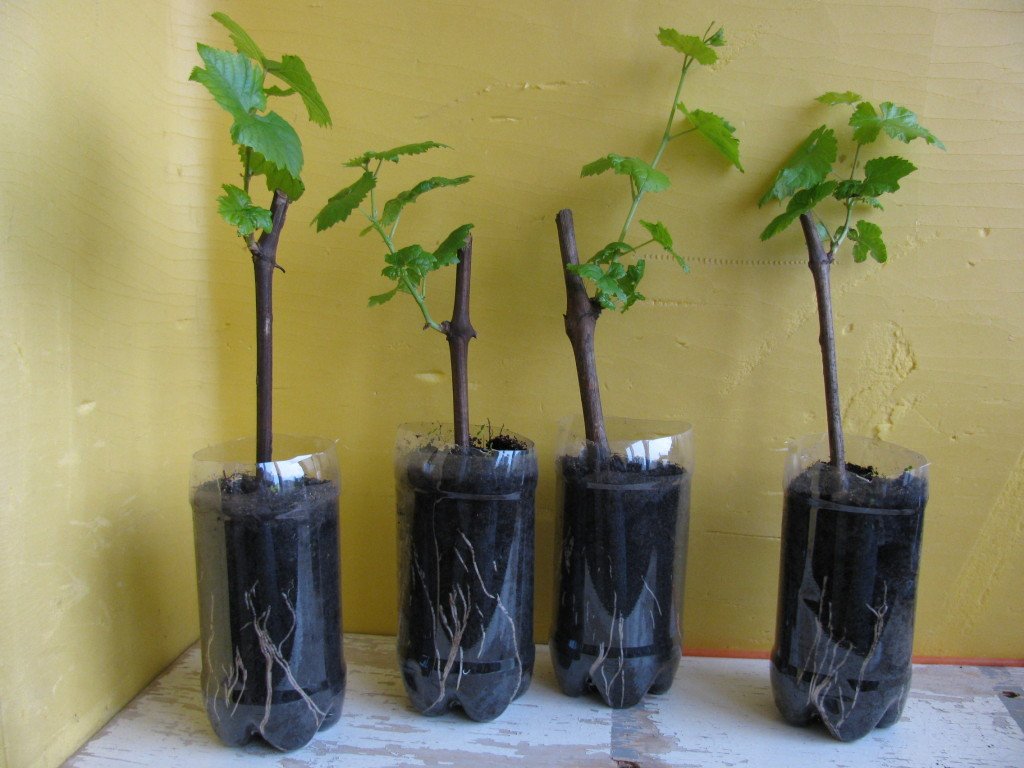Every gardener who has a vineyard on his site sooner or later has a question of renewal, replacement or expansion of the number of available vines. There are several ways to accomplish these tasks. One of them is the propagation of grapes using cuttings.
Content
Propagation of grapes by cuttings: technique and method features
Cutting is the process of selecting vines from a fruiting plant for subsequent germination and rooting. It is based on the great potential of grapes for self-healing and regeneration. Cutting is not the easiest way to propagate this garden culture, but at the same time it is one of the most popular.
A gardener can independently prepare cuttings (shanks) from existing plants. At the same time, you can be sure of the quality of the future grapes, since the new bush will carry all the qualities of the mother. Thus, it is possible to choose healthy vines with optimal yield, large berry size, disease resistance and other qualities of interest to the grower.
Cuttings in autumn
The autumn period is considered optimal for harvesting cuttings. By this time of the year, the vine accumulates the necessary amount of nutrients for the upcoming wintering.
When preparing cuttings, the following important points should be considered:
- the procedure should begin after the end of the leaf fall;
- for cutting, a grape bush with a stiff vine without signs of any disease is selected;
- the vine bore fruit in the past season;
- the stalk should be as straight and long as possible (about 60–80 cm), 7 to 10 mm thick.
Grape seedlings from cuttings. Harvesting, storage of planting material, germination and care:https://flowers.desigusxpro.com/en/yagody/vinograd/vyirashhivanie-vinograda-iz-cherenkov.html
After the cuttings are cut, they should be prepared for wintering and a storage location should be chosen. For this:
- After cutting, the cuttings are disinfected for about half an hour in a solution of potassium permanganate or 5% ferrous sulfate.
- If there are antennae, leaves, shoots on the cuttings, then they are removed.
- The lower part is cut in a straight line, and an inclined cut is made on the upper part at a distance of about 2 cm from the upper kidney.
- Before storage, the shanks are placed in water for up to 24 hours, since a vine saturated with moisture takes root best.
- On the bark in the lower part of the cutting for additional root formation with a sharp knife or needle, you can make several 3 cm grooves.
Don't forget to mark the cuttings if you are harvesting different grape varieties.
Storing cuttings
Different places are used for storing cuttings:
- In a cellar or basement. Optimum temperature - 2-6aboutC. For wintering, cut branches are placed on wet sawdust and loosely wrapped in polyethylene. During the winter, the planting material should be checked periodically so that it does not become moldy, rotted or dry out. If necessary, moisten the sawdust.
The higher the temperature at the storage site, the more likely it is that the cuttings will start developing earlier than planned. Because of this, in the future, they will take root worse.
- In the fridge. This method is suitable if a small number of cuttings are prepared. Usually the bottom shelf of the refrigerator is used, on which branches wrapped in a damp cloth and polyethylene are placed. It is necessary to check the condition of the cuttings from time to time.
- In the ground. This method is used if there is no suitable room for wintering or a large number of cuttings are prepared. The storage area should be elevated so that it does not become flooded in spring. A hole is dug up to 1 m deep, its length depends on the size of the cuttings. About 5 cm of wet sand is laid out on the bottom, on which the cuttings are placed. Then they are covered with another layer of wet sand (about 8-10 cm) and earth (25-30 cm).
It will be useful to install a canopy over the storage area and dig a small ditch for water drainage.
Cuttings in summer
In May or June, before the flowering of grapes (or during it), green cuttings are harvested:
- The procedure consists in breaking off a green shoot or a grape stepson. This is done in the evening or in the morning of a cloudy day.
- The branches must be placed in water, covered with a damp cloth and stored in a cool place, such as a basement, until morning.
- The next day they are taken out and cut into cuttings, removing the top and leaving two buds and two leaves on each.
- After that, the finished cuttings are again placed in water, and immediately before planting they can be kept for 10 hours in a Heteroauxin solution (0.5 tablets per 1 liter of water).
- For rooting, cuttings are planted in a container 40–50 cm deep, which is placed in a greenhouse or covered with polyethylene with ventilation holes. This is necessary to create high humidity. It is necessary to maintain it by spraying the planting material about 5 times a day until the roots appear, after which this procedure can be shortened up to 3 times.
- About a month after planting, they begin to open the grapes in the evening for 15 minutes, gradually increasing this interval to a whole day.
By autumn, with proper care, the seedlings will grow 40–50 cm and develop a good root system. During this time, the plants are dug up and stored in the basement until the spring planting in a permanent place.
Secrets of successful planting of grapes by cuttings, various methods of propagation: https://flowers.desigusxpro.com/en/yagody/vinograd/posadka-vinograda-cherenkami-vesnoy.html
Video: harvesting green cuttings
Preparing cuttings for rooting in spring
For spring grape cuttings, preparation should begin in late January or early February. During this period, cuttings are taken from storage sites and their condition is checked. To understand the quality of the material, you should press the pruner on the lower cut and look at the moisture that has appeared. Cuttings that have allocated a small volume of it are suitable for further use. The lack of moisture indicates that the cutting is dry, and a large amount indicates its decay.
After that, for two days, the cuttings that have passed the selection are soaked in warm settled water, which is changed daily. After this period, you can additionally keep the branches in a solution that stimulates root formation for 1–2 days. Then the cuttings are germinated in a convenient way for rooting and further planting in open ground.
Rooting cuttings
Before planting, the cuttings must be rooted.
Rooting at home
Conservative methods of planting grape cuttings at home are soil rooting and water germination.
Rooting in soil:
- For planting cuttings, it is necessary to prepare an appropriate container with a volume of 0.5 to 1 liter (plastic containers, cut plastic bottles, Tetra pak boxes, etc.).
- Drainage holes are necessarily made in the containers and a drainage layer is poured, for example, expanded clay or coarse sand.
- Then, soil without humus is poured onto 3/4 of the container height.
- Cuttings are planted in holes made in the soil, the remaining free space in the container can be filled with steamed sawdust. The landing level can be up to the upper kidney.
- Greenhouse conditions are created for seedlings, covering them with a film on top. You can place the planted shanks on the window, providing them with the required temperature: at the roots it should be 25aboutC, and at the top - up to 15aboutC. This is necessary in order for the roots to develop first, not the buds.
- Every day you should open the "greenhouse" for a short time and spray the cuttings.
- With the appearance of the first leaves, it is necessary to provide them with protection from the rays of the sun.
- Watering is carried out through the pallet 1 time in 2 days, leaving the containers with cuttings in water for 15–20 minutes.
Germination in water:
- The slices are updated on pre-soaked cuttings.
- A small amount of water (about 2–3 cm) is poured into a jar with a volume of 0.5-1 l and cuttings are installed. They can be placed in several pieces, but not too many. At first, a transparent viscous substance will stand out from the cut, therefore, during this period, the cuttings must be removed from the container and rinsed to avoid decay.
- It is necessary to monitor the water level and add it, and also change it often, preferably daily. To do this less often, you can add 1-2 tablets of activated carbon to the water.
- Since root formation is best done in the dark, you can wrap the jar with a material that does not transmit light.
- With this method, you should also maintain a different temperature level for the lower and upper parts of the cutting. If the buds have awakened before the roots appeared, then it is better to carefully remove the young shoots so that they do not take up most of the nutrients for themselves.
The roots begin to appear after about 3 weeks. A shank with a root length of 3 mm can be planted in the ground in order to provide them with the necessary amount of oxygen, which is not in the required volume in the water.
The longer the roots are, the more likely they are to break during transplantation.
Kilchevanie
The method of kilchevaya allows the rudiments of the root system to develop faster than shoots.Optimum elevated conditions of temperature and humidity conditions are created for the roots, and for the aboveground part of the plant they are deliberately reduced. Depending on the ambient temperature, it is necessary to either warm up the lower part of the plant, or cool the upper one. According to statistics, sprouted grape cuttings take root 3 times more often than sprouted by conventional methods.
It is necessary to take into account the timing of kilchevaya. This procedure lasts an average of 18-21 days, during this time callus is formed on the cuttings, which will become a harbinger of root development.
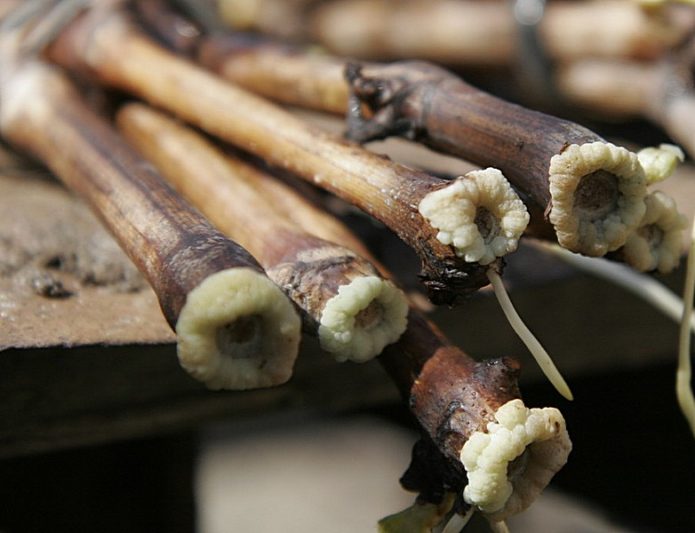
Callus is a plant tissue that forms on the surface of wounds of shoots or cuttings as a result of the division of nearby living cells
There are quite a few ways of kilchevka. In all cases, the cuttings are freshened in water and furrows are made in the lower part. Of course, the best quality in maintaining the desired temperature will be the use of an automatic kilchevator with an adjustment mechanism. It is important not to leave the process on its own and not to allow excessive growth of the callus layer, as this will subsequently complicate the germination of roots, forming a plug. It is possible to avoid this moment by setting the temperature for the lower part of the shank slightly lower than the generally accepted one (about 20aboutC) as well as checking the plants regularly.
Features of the technology of growing grapes in Siberia for beginners:https://flowers.desigusxpro.com/en/yagody/vinograd/vinograd-v-sibiri-dlya-nachinayushhih-posadka-i-uhod.html
Video: do-it-yourself grape killer
A more common method is when a special pit is being dug on the site for picking:
- When choosing its location, it is necessary to take into account that the place cannot be flooded, protected from the wind and available to sunlight. The depth depends on the length of the cuttings and averages 1.5–2 m.
- A layer of snow and / or ice is laid on the bottom of the pit and covered with straw or clay. You can also make an additional bottom from boards with holes.
- Then bundles of cuttings are placed in the pit, given that their upper part should be at the bottom of the pit, and the lower one should rise slightly above the surface.
- Further, the connected bundles must be alternately covered with layers of sand, wet sawdust and a mixture of humus with earth.
- In the end, everything is closed by a frame with glass at a distance of 25–30 cm from the top layer of the earth.
- During the kilchevka period, the covering substrate is kept moist with warm water.
If the temperature under the glass rises high (up to 30aboutC), then it is necessary to ventilate the space under it, and in case of cold nights, cover it.
Video: fishing in the ground
Other germination methods
At home, cuttings can also be germinated in other materials at hand.
In sawdust
Instead of the usual soil, cuttings can be germinated in sawdust of hardwood trees. The cuttings are previously, as usual, furrowed and placed in water for two days with the addition of honey (1 tsp per 10 liters). The sawdust is pre-steamed - they are poured with boiling water and cooled. After that, it is wrung out and placed wet in a container, for example, a bucket or container. Cuttings are placed in sawdust in an upright position. In this method, as in others, it is necessary to maintain the temperature difference between the lower and upper parts of the cutting. It will take about a month for the roots to germinate. During this time, it is necessary to periodically moisten the sawdust.
In potatoes
There is a way to germinate grape shanks, when ordinary potatoes are used as a food source. The prepared shank is simply stuck into a potato, from which the eyes are removed in advance. If it is a warm season, then the root crop with cuttings is dug in with earth and covered with film or plastic bottles. By autumn, such cuttings will be ready for wintering.
In coconut fiber
Coconut fibers are sold compressed. Before placing the cuttings, soak them with water.
One of the advantages of this material is its wastelessness. After germination of the grapes, the coconut substrate can be mixed with soil to plant the vines.
For germination, you can use any plastic containers that are suitable in size, on the bottom and sides of which ventilation holes are made. The coconut fiber is saturated with moisture enough to provide the stalk with it throughout the growing period. You just need to take care of closing the top of the container to avoid excess evaporation. If, nevertheless, the coconut dries up, then you can saturate it by adding a little water to the tray where the container is located.
Germinated cuttings care
When the roots of the cuttings reach a length of 3 mm, they must be transplanted into full-fledged soil for further growth before planting in an open place.
Soil preparation
The soil for planting cuttings should be light, have low acidity or neutral pH values. It can consist of fertile soil, sand and humus in equal parts. It is possible to add sawdust or replace the sand with perlite - this way the mixture will better retain moisture and become looser.
You can purchase ready-made soil for seedlings, focusing on the above parameters, as well as the presence of vermicompost, nutrients and minerals in it.
Transfer
Plastic cups or cut bottles with drainage holes can be used as transplant containers. The more spacious the container, the more opportunities the grapes have to grow into a strong plant. The optimal volume is 1–2 liters.
A small layer must be poured at the bottom for drainage. When filling the container, it is necessary to compact the soil a little, so as not to deprive it of its airiness, but also to prevent it from settling strongly afterwards. The cutting is usually deepened by 1/3 of the height of the container, leaving more room below for the development of the root system. During planting, make sure that the cutting is securely fixed in the container and does not fall. Planting should be done very carefully so as not to damage the small fragile roots. At the end of the procedure, the plant must be well watered.
Young grapes need good lighting conditions. If there is not enough natural light, then provide additional with phytolamps.
Watering
Watering should be started no earlier than 1.5–2 weeks after planting, since the cuttings have enough liquid for this time, which it was watered at that moment. To understand whether the plant needs moisture, you need to check the layer of earth at a depth of 4 cm - it must be dry. It is recommended to water with warm settled water through a sump as the soil layer dries out. The bay should not be allowed, as the roots of the grapes cannot stand it. It is also possible to water directly into a container in a volume equal to a small glass per liter of soil. Carefully loosen the soil to avoid crusting. If the humidity in the room is not high, you can spray the top of the grapes with a spray bottle daily.
Top dressing of transplanted cuttings
If the soil is bought for planting, then there are already enough nutritional supplements in it. In this case, there is no need to feed the cuttings.
In the case of self-collection of the soil mixture for feeding, you can use industrial fertilizers, which are diluted in water and applied along with irrigation. You can use drugs:
- Health Aqua,
- Florovit,
- Blank slate and others.
Video: caring for vegetative seedlings
Preparing cuttings for planting
Grape cuttings that have grown and turned into seedlings are planted when the air temperature outside becomes stable and not lower than 10aboutC. Usually such conditions fall in May.
In extreme cases, you can land at the very beginning of June, but not later. Otherwise, the young plant will not have time to "settle down" in a new place and keep within the rest of the growing season.
By the planned time, at least 4 leaves should grow on the cuttings. The number of roots is 3 or more, their length is about 8 cm. This will be easy to track if you initially use a transparent container for growing. It is first necessary to harden the cuttings by taking them outside in a shady place during the day for 5-7 days.
Grafting grapes in spring with cuttings
If it was not planned to allocate additional space in the garden for the expansion of the vineyard, then it is possible to graft the cuttings into the prepared stock. In this case, it is not necessary to pre-germinate the material. Also, the time required for the rooting of the vine will be reduced, and, accordingly, the waiting period for the first harvest. There are aboveground and underground ways grape grafting... The second is considered more preferable, since in this case more cuttings take root. However, this method is more labor intensive.
Root grafting
An additional difficulty with underground grafting is that it is necessary to completely remove the aboveground part of the grapes that will be used as a rootstock. In this case, the plant is dug in to a depth of 20 cm, the old stem is cut down, the cut is cleaned with a clean knife and wiped with a cloth. Depending on the size of the stem, up to 4 previously prepared cuttings can be grafted into it. The preparation procedure includes placing them in water for two days so that they are saturated with moisture, as well as immediately before inoculation into a solution with a growth stimulator (0.5 tablets of Heteroauxin per 1 liter of water) for 5–7 hours.
Procedure:
- 3–5 cm in the lower part of the shank is sharpened under the wedge and inserted into the split on the rootstock, which is done according to the depth of sharpening of the cutting with a knife or chisel.
- The tool is left in the split and removed after the parts of the future plant are connected together.
- The grafting site is pulled together with a rope (twine) or a plaster, layered with wet paper, clay and paper again.
- Fall asleep with earth along with the upper kidney.
- The resulting hill can be covered with polyethylene, making a hole in it for a future escape. After its appearance, the layer of earth can be removed.
Tips for Beginners
To avoid serious problems during the entire long cuttings procedure, you should adhere to the basic tips:
- At the time of harvesting the cuttings, it is worth choosing the ripened, lignified parts of the vine - unlike young green ones, sap flows more intensively in them, making them easier to take root.
- It is recommended to disinfect the instrument after each cut to prevent contamination of the material.
- To minimize the loss of moisture during storage, the cuttings are treated with paraffin.
- When germinating, a hydrogel can be added to the soil for additional moisture retention. This will not be an obstacle - the roots will grow through it perfectly.
- In the conditions of the middle lane before spring planting, the option of early rooting of cuttings (at the end of February) with subsequent rearing than later, but with planting directly into the ground, is considered optimal.
- When growing, plant grapes in transparent containers to monitor the development and condition of the root system.
Table: difficulties in growing cuttings and ways to overcome them
| Problem | Possible reasons | Solution method |
| Cuttings dry and curl leaves | Excess nitrogen fertilization or improper soil acidity. | It is necessary to remove the stalk and inspect the roots, if damaged roots are found, remove them, rinse the branch and transplant into a suitable soil. |
| The roots of cuttings darken | Root decay during overflow. | Reduce or temporarily stop watering, or remove rot and root the cutting again. |
| Leaves turn yellow and turn pale | Insufficient lighting. | Choose a brighter spot or use additional artificial light. |
| Roots do not appear |
|
|
| Cuttings dry | Overflowing. | Reduce or temporarily stop watering. |
Cutting grapes is a low-cost and time-saving way to renew your plants or expand your plantation. Even a beginner can master this process.
